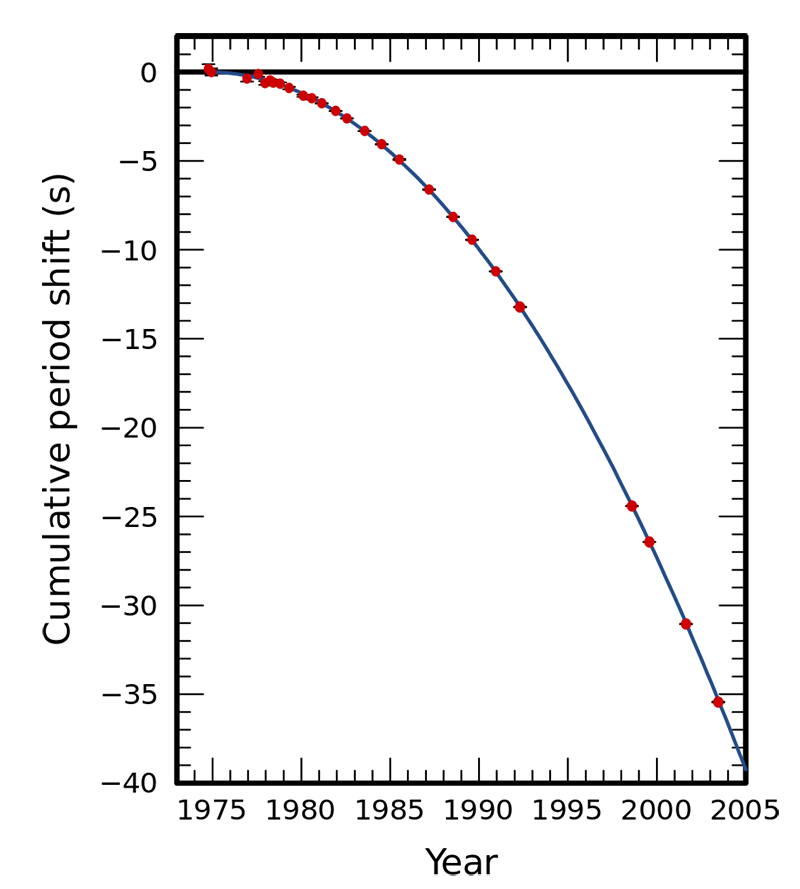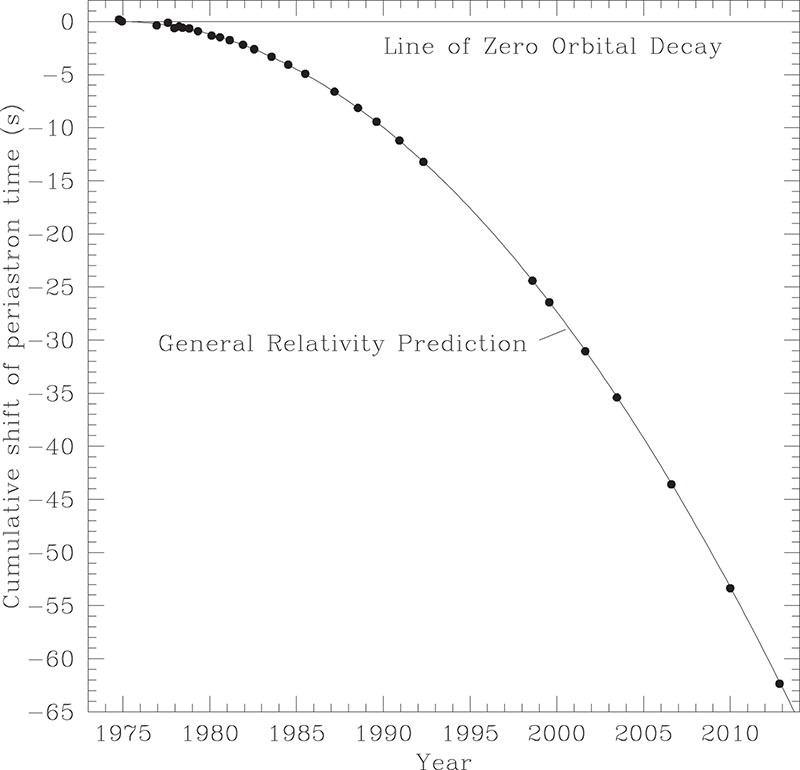Binary Pulsar Affirms General Relativity and Cosmic Creation Event
Featured image: Artistic Impression of Two Pulsars Orbiting around a Common Center of Mass
Image credit: Michael Kramer (Jodrell Bank Observatory, University of Manchester)
The most rigorous and compelling proof that the universe was created by an Agent that transcends space and time comes from the theory of general relativity. The best confirmation that general relativity is a true theory comes from measurements on the binary pulsar PSR B1913+16. Thanks to a new study, that best confirmation has now become even better.
Astronomers have been studying the binary pulsar PSR B1913+16 for nearly four decades. In a recent issue of the Astrophysical Journal, astronomers Joel Weisberg and Yuping Huang published their analysis of 9,257 pulse times-of-arrival measurements taken over 35 years on PSR B1913+16.1
PSR B1913+16 is a pair of neutron stars where one of the neutron stars is a pulsar. The two neutron stars orbit one another with a period of 7.75 hours and an orbital separation of just 3 light-seconds (a little more than twice the separation of the moon from Earth or about two-thirds the diameter of the sun). The pulsar rotates on its axis about 17 times per second. Thus, it sends out a strong pulse of radiation every 59 milliseconds.
The theory of general relativity predicts that neutron stars orbiting close to one another will radiate gravitational waves. This radiation will cause the neutron stars to experience a decay in their orbit—that is, the neutron stars will orbit closer and closer to one another as gravitational energy is radiated away by the gravitational waves.
The easiest and most accurate way to measure the orbital decay is to determine changes in the timing of periastron of the orbit. Periastron refers to the position in the orbit at which two stars orbiting each other are closest to one another. The orientation of periastron in PSR B1913+16’s orbit has been observed to change by 4.2° per year. Figure 1 shows the observed change in the timing of periastron from 1975 to 2003 compared to what the theory of general relativity would predict.2
Figure 1: Orbital Decay of the Binary Pulsar PSR B1913+16 (1975–2003)
The data points show the observed change in the epoch of periastron from 1975 to 2003. The parabolic curve shows the change in epoch predicted by the theory of general relativity.
Figure 2 shows the observed change in the timing of periastron from 1975 to 2014.3 The newer measurements show an even more spectacular agreement with the prediction arising from the theory of general relativity.
Figure 2: Orbital Decay of the Binary Pulsar PSR B1913+16 (1975–2014)
The data points show the observed change in the epoch of periastron from 1975 to 2014. The error bars on the post-1980 data points are much too small to show.
Image credit: Weisberg and Huang, Astrophysical Journal
Until the publication of Weisberg and Huang’s paper, the best comparison of the observed orbital period decrease of PSR B1913+16 compared to the prediction of general relativity was 0.997 ± 0.002.4 Weisberg and Huang’s work improves that comparison to 0.9983 ± 0.0016.5 Their results remove any reasonable doubt for “the existence and strength of gravitational radiation as predicted by general relativity.”6
In their paper, Weisberg and Huang also announce two never-before-performed tests of general relativity. They successfully measured, for the first time in this system, the “two parameters characterizing the Shapiro gravitational propagation delay.” (The Shapiro gravitational propagation delay is the slowing down of the passage of light, predicted by general relativity, as that light experiences a change in gravitational potential caused by the gravitational field of a massive body.) Their measured values were consistent with general relativity’s predictions.7 They also successfully measured, for the first time in any system, the shape correction to the elliptical orbit of PSR B1913+16. The shape correction they measured was consistent with the prediction arising from general relativity.8
Even before the publication of Weisberg and Huang’s paper, general relativity ranked as the most exhaustively tested and best-proven principle in physics. With the addition of Weisberg and Huang’s research findings, general relativity is now even more exhaustively tested and better proven. Thanks to Weisberg and Huang’s additional tests of general relativity’s veracity, the conclusions of the space-time theorems are now even more solid than they were before.
The space-time theorems rest on just two significant (nontrivial) assumptions: (1) the universe contains bodies that possess mass, and (2) the equations of general relativity reliably describe the movements of massive bodies. Readers of this blog, by themselves, are adequate evidence that assumption 1 is correct. Thanks to Weisberg and Huang’s research findings and the research findings of others, no reasonable basis now exists for doubting assumption 2.
The most potent space-time theorem—the one proven by Arvind Borde, Alexander Vilenkin, and Alan Guth—states that all cosmological models are subject to an initial space-time singularity, regardless of assumptions about homogeneity, isotropy (or lack thereof), or energy conditions, including cosmological models that invoke an early hyperinflation event.9 This beginning of space and time implies that an Agent operating from beyond space and time must have caused the universe to exist.
About a year after the publication of the theorem, Alexander Vilenkin wrote in a book, “With the proof now in place, cosmologists can no longer hide behind the possibility of a past-eternal universe. There is no escape, they have to face the problem of a cosmic beginning.”10 That problem is a causal Agent who transcends space and time. Such a causal Agent matches the description of the God of the Bible.
Endnotes
- Joel Weisberg and Yuping Huang, “Relativistic Measurements from Timing the Binary Pulsar PSR B1913+16,” Astrophysical Journal 829 (September 2016): id. 55, doi:10.3847/0004-637X/829/1/55.
- Joel Weisberg, David Nice, and Joseph Taylor, “Timing Measurements of the Relativistic Binary Pulsar PSR B1913+16,” Astrophysical Journal 722 (September 2010): 1030–34, doi:10.1088/0004-637X/722/2/1030.
- Weisberg and Huang, “Relativistic Measurements,” 9.
- Weisberg, Nice, and Taylor, “Timing Measurements,” 1034.
- Weisberg and Huang, “Relativistic Measurements,” 1.
- Ibid.
- Ibid.
- Ibid.
- Arvind Borde, Alan Guth, and Alexander Vilenkin, “Inflationary Spacetimes Are Incomplete in Past Directions,” Physical Review Letters 90 (April 2003): id. 151301, doi:10.1103/PhysRevLett.90.151301.
- Alexander Vilenkin, Many Worlds in One: The Search for Other Universes (New York: Hill & Wang, 2007), 176.








